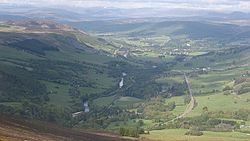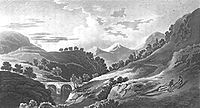Pass of Killiecrankie
| Killiecrankie | |
|
| |
|---|---|
 Glengarry | |
| Grid reference: | NN913628 |
| Location: | 56°44’50"N, 3°46’37"W |
| Information | |
| Website: | Pass of Killiecrankie |
The Pass of Killiecrankie is a mountain pass through the hills of near the village of Killiecrankie in Perthshire. It was the site of the Battle of Killiecrankie in 1689.
The pass is three miles north of Pitlochry and crosses the mountains of Perthshire at just 462 feet above sea level between Ben Vrackie (2,759 feet) and Tenandry Hill, where the River Garry flows through, now carrying the A9 road. The village of Killiecrankie stands at the northern end of the pass, and Pitlochry at its south.
The river-gorge traverses the pass over the course of a mile, and above it, the road and the railway.
About a mile toward the village of Killiecrankie, the Battle of Killiecrankie took place in 1689.[1]

Battle
The Battle of Killiecrankie was the first major action of the uprising which was triggered when King James VII & II was deposed in 1689. James, a professed Roman Catholic, dismissed the parliaments of Scotland and England and ruled autocratically, dispensing with "inconvenient" laws until in 1688 William of Orange landed and in December James fled to France, the Parliaments of both realms offering the throne to William and Mary. The Glorious Revolution was almost bloodless in England but several of the Highland clans rose in support of their expelled king under the leadership of "Bobbing John" Graham of Claverhouse, Marquess of Dundee.
Through the passes of Perthshire came the Highlanders, with their eyes on the Lowlands and Edinburgh. Blair Castle was a key position that controlled access to the Lowlands and Dundee marched swiftly for it. On 17 July 1689 he arriving at the Pass of Killiecrankie before the government forces led by Hugh Mackay, himself a Highlander. Dundee occupied the high ground and Mackay could but engage in long-range musket fire for several hours.
Mackay had more men and the Jacobites' flanks were open line, and at seven o'clock, when the sun was out of their eyes, Dundee ordered the attack. The fearsome Highland charge began: a crashing musket volley followed by a charge with sword, buckler and dirk into Mackay's line. The lines met and Mackay's men in the centre were "swept away by the furious onset of the Camerons." So fast was the Jacobite charge that many government troops had insufficient time to fix their bayonets, leaving them defenceless at close-quarters.
The battle soon ended with the entirety of Mackay's force fleeing the field, quickly turning into a rout that killed 2,000. Of the victorious Highlanders though, about one-third fell, and Dundee was fatally wounded. The Jacobite advance continued until being stopped by government forces at the Battle of Dunkeld. Thus this stunning victory for the Jacobites had little overall effect on the outcome of the war and King William ruled securely for the rest of his reign.
The battlefield is owned by the National Trust for Scotland.
References
- ↑ "Killiecrankie, Tenandry and Strathgarry". Tour Scotland. http://www.fife.50megs.com/killiecrankie2.htm. Retrieved 2007-12-18.]
